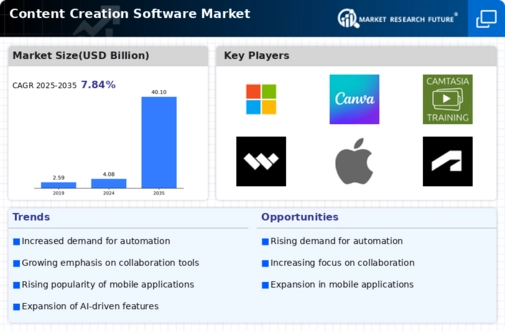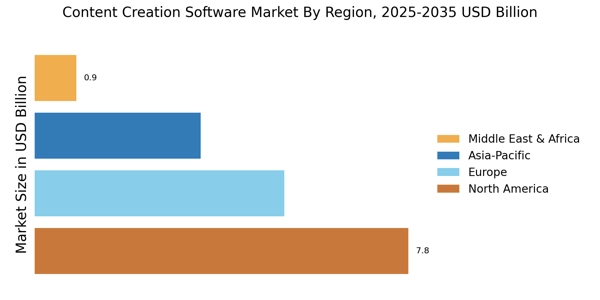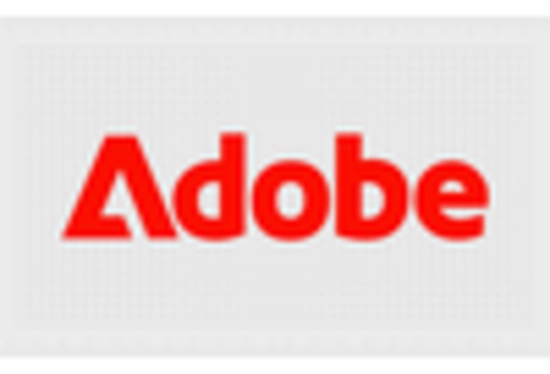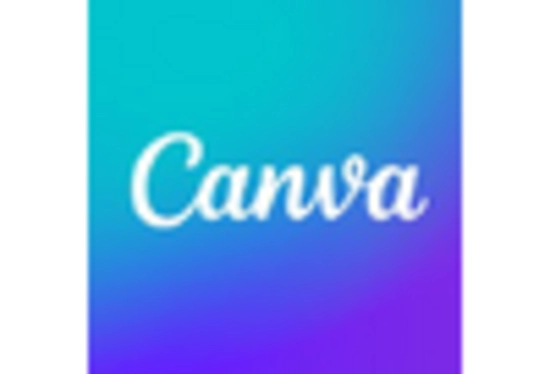Emergence of E-Learning Platforms
The Content Creation Software Market is significantly influenced by the rise of e-learning platforms, which have become essential in educational settings. As educational institutions and corporate training programs increasingly adopt digital learning methodologies, the demand for content creation tools tailored for educational purposes escalates. The market for e-learning is expected to reach approximately 375 billion dollars by 2026, indicating a substantial opportunity for software developers. These tools facilitate the creation of interactive and engaging learning materials, enabling educators to deliver content that caters to diverse learning styles. As a result, the Content Creation Software Market is poised for growth, driven by the necessity for innovative solutions that enhance the learning experience.
Increased Demand for Video Content
The Content Creation Software Market experiences a notable surge in demand for video content, driven by the proliferation of social media platforms and the growing preference for visual storytelling. As businesses and individuals seek to engage audiences more effectively, the need for sophisticated video editing and production tools becomes paramount. According to recent data, video content is projected to account for over 80% of all internet traffic by 2025, underscoring the urgency for content creators to adopt advanced software solutions. This trend not only enhances user engagement but also fosters brand loyalty, as compelling video narratives resonate with viewers. Consequently, the Content Creation Software Market is likely to witness a robust expansion as developers innovate to meet the evolving needs of content creators in this dynamic landscape.
Rise of Remote Work and Collaboration
The Content Creation Software Market is witnessing a notable shift due to the rise of remote work and collaboration. As organizations adapt to flexible work environments, the demand for tools that facilitate collaborative content creation has surged. Software solutions that enable multiple users to work on projects simultaneously are becoming increasingly essential. Recent data suggests that nearly 50% of the workforce is now engaged in remote work, highlighting the need for effective collaboration tools. This trend indicates that the Content Creation Software Market will continue to evolve, as developers focus on creating solutions that enhance teamwork and streamline the content creation process, ultimately catering to the needs of a distributed workforce.
Advancements in Artificial Intelligence
The Content Creation Software Market is significantly shaped by advancements in artificial intelligence, which are revolutionizing the way content is created and optimized. AI-driven tools are increasingly being integrated into content creation software, enabling users to automate repetitive tasks, enhance creativity, and improve efficiency. For instance, AI algorithms can analyze user preferences and suggest content ideas, thereby streamlining the creative process. The market for AI in content creation is projected to grow substantially, with estimates suggesting a compound annual growth rate of over 25% in the coming years. This rapid evolution indicates that the Content Creation Software Market is likely to adapt and innovate in response to the capabilities offered by AI technologies, ultimately enhancing the user experience.
Growing Importance of Social Media Marketing
The Content Creation Software Market is experiencing a transformation due to the growing importance of social media marketing. Businesses are increasingly recognizing the need to create high-quality, shareable content to enhance their online presence and engage with target audiences. As social media platforms evolve, the demand for tools that streamline content creation, scheduling, and analytics is on the rise. Recent statistics indicate that over 70% of marketers believe that social media marketing has been effective for their business, further driving the need for specialized software. This trend suggests that the Content Creation Software Market will continue to expand as companies seek to leverage innovative tools to optimize their social media strategies and improve overall marketing effectiveness.


















Leave a Comment